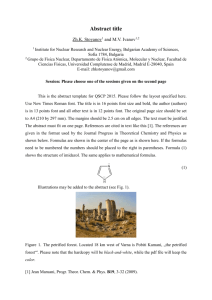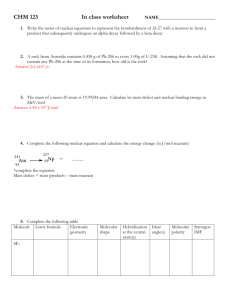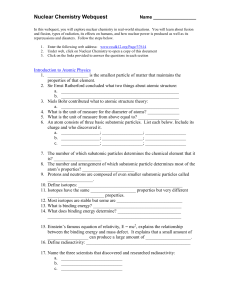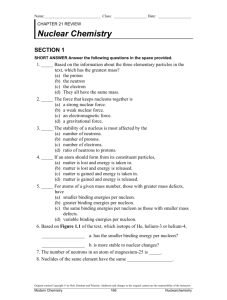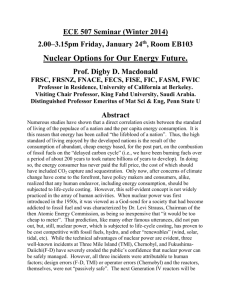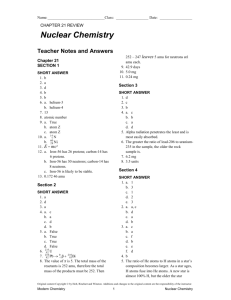005_LHA_CH04.qxd
advertisement
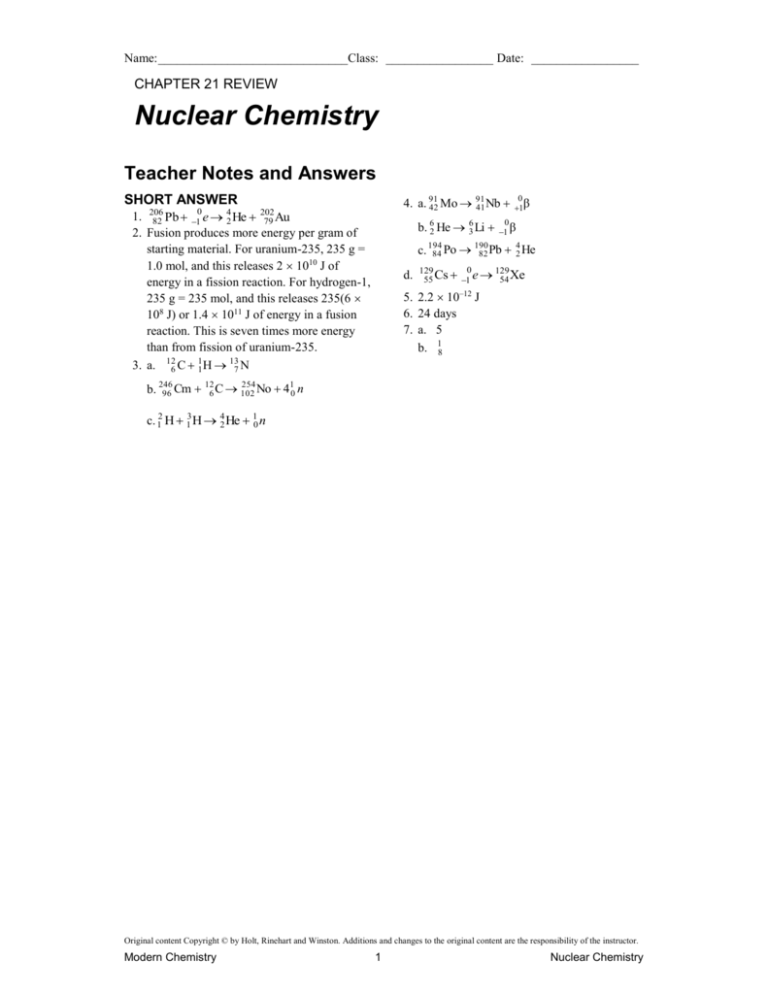
Name: ______________________________Class: _________________ Date: _________________ CHAPTER 21 REVIEW Nuclear Chemistry Teacher Notes and Answers SHORT ANSWER 91 4. a. 91 42 Mo 41 Nb 0 206 4 202 82 Pb 1 e 2 He 79 Au 1. 2. Fusion produces more energy per gram of starting material. For uranium-235, 235 g = 1.0 mol, and this releases 2 1010 J of energy in a fission reaction. For hydrogen-1, 235 g = 235 mol, and this releases 235(6 108 J) or 1.4 1011 J of energy in a fusion reaction. This is seven times more energy than from fission of uranium-235. 3. a. 126 C 11 H 137 N b. 62 He 36 Li 0 1β 0 1 β 190 4 c. 194 84 Po 82 Pb 2 He d. 0 129 129 55 Cs 1 e 54 Xe 5. 2.2 10–12 J 6. 24 days 7. a. 5 b. 18 12 254 1 b. 246 96 Cm 6 C 102 No 4 0 n c. 12 H 13 H 42 He 10 n Original content Copyright © by Holt, Rinehart and Winston. Additions and changes to the original content are the responsibility of the instructor. Modern Chemistry 1 Nuclear Chemistry Name: ______________________________Class: _________________ Date: _________________ CHAPTER 21 REVIEW Nuclear Chemistry MIXED REVIEW SHORT ANSWER Answer the following questions in the space provided. 1. The ancient alchemists dreamed of being able to turn lead into gold. By using lead-206 as the target atom of a powerful accelerator, modern chemists can attain that dream in principle. Write the nuclear equation for a one-step 206 process that will convert 82 Pb into a nuclide of gold-79. You may use alpha particles, beta particles, positrons, or protons. _______________________________________________________________ 2. A typical fission reaction releases 2 1010 kJ/mol of uranium-235, while a typical fusion reaction produces 6 108 kJ/mol of hydrogen-1. Which process produces more energy from 235 g of starting material? Explain your answer. _______________________________________________________________ _______________________________________________________________ _______________________________________________________________ _______________________________________________________________ 3. Write the nuclear equations for the following reactions: a. Carbon-12 combines with hydrogen-1 to form nitrogen-13. _______________________________________________________________ b. Curium-246 combines with carbon-12 to form nobelium-254 and four neutrons. _______________________________________________________________ c. Hydrogen-2 combines with hydrogen-3 to form helium-4 and a neutron. _______________________________________________________________ 4. Write the complete nuclear equations for the following reactions: a. 91 42 Mo undergoes positron emission. _______________________________________________________________ b. 62 He undergoes beta decay. _______________________________________________________________ c. 194 84 Po undergoes alpha decay. _______________________________________________________________ Original content Copyright © by Holt, Rinehart and Winston. Additions and changes to the original content are the responsibility of the instructor. Modern Chemistry 2 Nuclear Chemistry Name: ______________________________Class: _________________ Date: _________________ MIXED REVIEW continued d. 129 55 Cs undergoes electron capture. _______________________________________________________________ PROBLEMS Write the answer on the line to the left. Show all your work in the space provided. 5. __________________ It was shown in Section 1 of the text that a mass defect of 0.030 377 u corresponds to a binding energy of 4.54 3 10212 J. What binding energy would a mass defect of 0.015 u yield? 6. __________________ Iodine-131 has a half-life of 8.0 days; it is used in medical treatments for thyroid conditions. Determine how many days must elapse for a 0.80 mg sample of iodine-131 in the thyroid to decay to 0.10 mg. 7. Following is an incomplete nuclear fission equation: 235 1 90 92 U 0 n 38 Sr 1 141 54 Xe x 0 n energy _____ a. Determine the value of x in the above equation. _____ b. The strontium-90 produced in the above reaction has a half-life of 28 years. What fraction of strontium-90 still remains in the environment 84 years after it was produced in the reactor? Original content Copyright © by Holt, Rinehart and Winston. Additions and changes to the original content are the responsibility of the instructor. Modern Chemistry 3 Nuclear Chemistry


